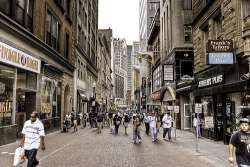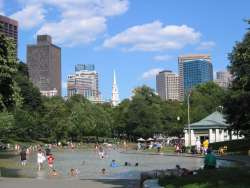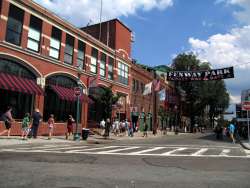|
CHARLESTOWN
Home of Boston's Navy Yard, Charlestown is most famous as the site of the Battle of Bunker Hill on 17 June, 1775. Rebuilt after the Revolution, it remained a separate town until 1874 when it was absorbed by Boston. Long a bastion of Irish settlement, Charlestown's narrow streets and cosy townhouses began atracting young professionals in the 1980's. Today it is a safe, desirable residential neighborhood within easy walking distance of downtown Boston and its attractions. |
|
________________________________________________________________________________________________________________________________________
|
NORTH END
Boston's oldest neighborhood, home of Paul Revere and North Church. By the late 19th century, the wooden tenements of Colonial times had given way to the brick tenements of today, and its population had transitioned from Yankee to Irish to Jewish to Italian. Long isolated from the rest of Boston by the elevated Central Artery, the North End has preserved its narrow, winding "cowpath" streets and predominantly Italian character. Today offers a rich assortment of restaurants, bakeries, cheese shops, cafes, summer street festivals and urban life at its best. |
 |
________________________________________________________________________________________________________________________________________
|
ROSE KENNEDY GREENWAY
Winding along the path of Boston's former Central Artery, the Rose Kennedy Greenway is Boston's newest park, or rather series of parks. For many years the elevated Central Artery provided motorists with a convenient bypass through the heart of the city, but by the 1980's had become a clogged, blighted eyesore. The solution to the problem was the "Big Dig", an unprecedented move to bury the Artery below street level and transform the surface into a pedestrian paradise. Twenty years and $15 billion later, the "Tip O'Neill Tunnel" has removed most of the car traffic out of sight, but cost overruns have reduced expectations for the Greenway. Rather, it is now seen more as a promise for the future as the trees grow and the city knits itself back together. |
 |
________________________________________________________________________________________________________________________________________
|
DOWNTOWN CROSSING
Boston's traditional shopping center, where Summer and Winter Streets meet and where Filene's and Jordan Marsh once competed for customers. Don't get your hopes up- Downtown Crossing is in the midst of a transition. Jordan Marsh is now Macy's and Filene's with its famous bargain basement is no more. Only the facade of the original building remains along with its clock and chimes. The building site is scheduled for redevelopment as a luxury office/residential/commercial complex, but the economy has stalled progress and left the site as little more than an excavation for now. More promising is the current restoration of the old Paramount Theatre by Emerson College, which, together with Suffolk University, is in the process of moving into and reviving Downtown's "Ladder District" between Washington and Tremont Streets. And for those interested in browsing for rare and second-hand books, the venerable Brattle Bookshop can still be found at 9 West St. |
 |
________________________________________________________________________________________________________________________________________
|
BOSTON COMMON
Where cows once grazed, British Regulars drilled and criminals were hanged, children now wade and splash in the Frog Pond and summer performances of Shakespeare on the Common are staged. Boston Common covers 50 acres (20 ha) set aside for public use in 1634 and has remained a place where all but the most illegal of activities are tolerated. Besides the frog Pond, the Common contains the old Central Burying Ground, the Parkman Bandstand, the Soldiers and Sailors Monument, the recently restored Brewer Fountain, two MBTA stops and the Robert Gould Shaw Memorial facing the State House. It also serves as the starting point for Boston's Freedom Trail. |
 |
_______________________________________________________________________________________________________________________________________
|
BOSTON PUBLIC GARDEN
When Boston began to expand westward in the early 19th century by filling in the old "Back Bay", among the first parcels of land to be developed was a 24 acres (10 ha) site set aside in 1856 as the nation's first botanical garden. Today, the Public Garden is a carefully cultured landscape of ornamental trees, flower beds, lawns and walks surrounding a central pond spanned by the world's smallest suspension bridge. Statuary abounds, including a prominent equestrian figure of Washington and the ever popular "Make Way for Ducklings" group commemorating the beloved childrens story. From mid-April to mid-September, one can cruise the pond on another of Boston's attractions, the famed Swan Boats. |
 |
________________________________________________________________________________________________________________________________________
|
BEACON HILL
One of Boston's most historic and exclusive neighborhoods, Beacon Hill was developed in the early 19th century after much of the original hill was leveled for construction of the nearby State House. Early on, attached row houses supplanted freestanding residences as land values rose, and brick became the dominant building material to ensure against fire. Unlike other neighborhoods, Beacon Hill remained a Yankee stronghold throughout its history, with many Boston "Brahmin" families maintaining their town houses here while summering in their rural countryside or seaside estates. In 1962, Beacon Hill became a National Historic Landmark and survives, complete with its gaslights and uneven brick sidewalks, virtually unchanged to this day. |
 |
________________________________________________________________________________________________________________________________________
|
BACK BAY
With its population rapidly growing in the early 19th century, Boston looked to its surrounding tidal flats for expansion. In the 1850's filling operations began in the large basin west of Charles St. Within 10 years, most of this "Back Bay" became dry land with a street grid (unusual for Boston) dividing the land into rectangular blocks and lots. Throughout the 1870's, 80's and 90's, brick row houses arose in every conceivable architectural style, but within a tightly regulated master plan that imposed a strong sense of physical unity to the neighborhood. With the construction of the Prudential Center in the 1960's, commercial development along Boylston St spread to Newbury St, which soon became (and still remains) Boston's premiere chic shopping street. Today, the Back bay is a lively mix of stylish shops and restaurants with upscale residential living, which showcases Boston at its best. |
 |
________________________________________________________________________________________________________________________________________
|
FENWAY
To most Bostonians and visitors alike, this neighborhood west of the Back Bay means only one thing: RED SOX BASEBALL. On game days, streets are clogged, the T is mobbed, parking rates quadruple, street parking is non-existent and the sidewalks turn into a lively festival of sausage vendors, souvenir hawkers, ticket scalpers and Sox fans. After hours, the bars and clubs fill up with students from nearby Boston University and Northeastern, making for loud, lively weekend nights, especially after Red Sox wins. Dominating the area, Fenway park, built in 1913, remains the nation's oldest baseball stadium, where, despite recent additions and enlargements, one can still enjoy baseball the old fashioned way. |
 | |